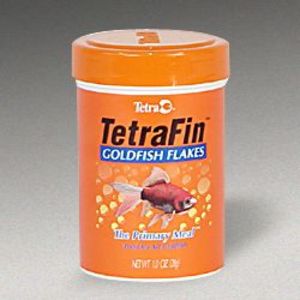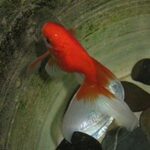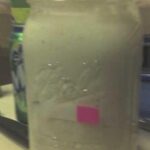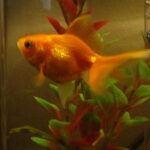I am relatively new to the aquarium world, although I have kept goldfish off and on since I was a little kid. Recently my wife and I purchased a Top Fin goldfish aquarium starter kit, and I got to relearn the entire fish keeping and caring process all over again. One thing that I have always taken for granted when keeping fish is the ingenuity involved in manufacturing a successful fish food. After I had set up my new aquarium, I began feeding my new goldfish (a calico fantail and an orange fantail with black spots). While I was feeding them I was struck with the cleverness of such a simple product as a goldfish flake and how much trial and error must have been put into the design and production of a perfect fish food that provides adequate nutrition, is attractive to the fish, and that promotes a healthy tank. While I am not a biologist and am not qualified to evaluate every detail of the adequacy of the TetraFin goldfish flakes, I would like to share some of the lessons I have learned by trial and error, as well as by research, about how to effectively use TetraFin goldfish flakes to feed goldfish.
Lesson #1: Food Quantity
A common mistake many beginner goldfish keepers make is to overfeed their pet goldfishes. I have made this mistake many, many times in the past, almost always with unhappy results. While I do not believe I have ever lost a fish to death due directly to overfeeding, overfeeding goldfish can lead to poor tank conditions and may be the indirect cause of your fishes’ demise. A good rule of thumb to remember is that a goldfish’s stomach is approximately the size of its eye. You should not feed your goldfish more than will fit in its stomach at any one feeding. To do so can harm the fish, especially since goldfish will go right on eating, even when their stomachs are full.
Another problem with overfeeding is that the consumption of more TetraFin flakes than are necessary will cause tank conditions to worsen. One reason for this is that an increase in food consumption causes a direct increase in the fecal waste produced by the goldfish. This puts an increased strain on the mechanical and/or biological filtrations system that oxygenates the tank water and removes the waste. You will find that the tank water quality deteriorates very rapidly if you overfeed your goldfishes. The water quality of your tank will also decrease as a result of any uneaten food that is left over after your goldfish have consumed their meal. Any uneaten food will settle into the gravel and decay, which again puts additional strain on a tank’s filtration system.
A good rule of thumb for feeding smaller goldfish is to feed only two to four medium sized TetraFin flakes for every goldfish in your tank at one feeding. You should repeat this process two to three times a day, ensuring that all of the food gets consumed and that none is left over in the tank to decay. I have found that feeding only the medium to large size TetraFin flakes to the fish will reduce the waste in the tank because the fish are able to see the flakes quite easily. If you allow very small flakes to enter the tank, you run the risk of your goldfish not seeing the flakes and leaving them uneaten to decay on the tank floor.
Lesson #2: Flakes versus Pellets
TetraFin goldfish flakes are not ideal. Experts seem to disagree on this point. One concern about goldfish flakes in general is that the goldfish, when consuming food at the surface of the water, end up consuming a fair amount of air into their digestive system. The consumed air bubbles must pass through the goldfish’s digestive tract and they are apparently quite dangerous to the health of the fish. I have noticed this in my own fish when thhe fish excrete their fecal matter. Sometimes I will notice that there are air bubbles trapped within the feces (which then causes the feces to float at the top of the tank, grossly enough) after having fed my goldfish exclusively with goldfish flakes. Often food pellets are cited as the proper answer to this problem, since the pellets immediately sink to the tank’s floor and the goldfish feed from the tank’s bottom rather than the top where the air is located.
I have not had much success with goldfish pellets instead of flakes. One reason for this is that the fish seem to have a harder time finding and consuming the entire amount of food I place in the tank. This causes all the problems with waste and water quality I referred to in lesson #1 above. I have found that sorting through and using exclusively the larger goldfish flakes will cause the fish to consume mainly the flake instead of a giant gasp of air when feeding from the top. After observing the feces from my goldfish when sticking exclusively to the larger flakes in the TetraFin food container, there is a noticeable difference in the volume of air bubbles that are trapped in my goldfishes’ fecal matter. So the same lesson applies here as in lesson #1: stick to just enough large flakes to feed your fish without overfeeding. This creates a healthier tank and is healthier internally for your goldfish’s well being.
In conclusion, TetraFin goldfish flake food is a simple way to feed your fish adequate nutrition, as long as you take some basic precautions against overfeeding and are aware of the inherent dangers to your fish when feeding off flake food exclusively. As for how they make goldfish flakes, I have no idea, but it must be a fascinating process to manufacture the perfect flake that floats just long enough for the fish to feed and is attractive to the fish. Better geniuses than I are responsible for this marvelous invention that allows me to keep my beautiful goldfish alive for years at a time with very little effort on my part. Here’s to the TetraFin folks!




